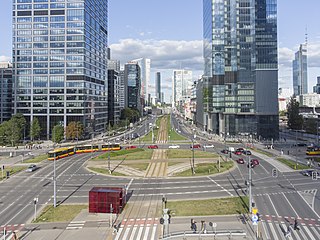
Lubań, sometimes called Lubań Śląski ; is a town in the Lower Silesian Voivodeship in southwest Poland. It is the administrative seat of Lubań County and also of the smaller Gmina Lubań.

Wola is a district in western Warsaw, Poland. An industrial area with traditions reaching back to the early 19th century, it underwent a transformation into a major financial district, featuring various landmarks and some of the tallest office buildings in the city.

The Warsaw Stock Exchange (WSE) is a stock exchange in Warsaw, Poland. Founded in 1817, it was located in the Saxon Palace until 1877 when it was moved to the Exchange Building at the Saxon Garden. Currently, it is located at ul. Książęca 4 in the Śródmieście District of Warsaw in the Exchange Center Building opened in 2000. As of September 2024, there are 410 companies, including 42 foreign ones, quoted on the stock exchange whose market capitalization amounts to PLN 1.50 trillion, making it the largest stock exchange in Central and Eastern Europe. The most important stock market indices of the Warsaw Stock Exchange are WIG20, WIG30, MWIG40 and SWIG80. Trading at Warsaw runs from 08:30 to 17:00 with closing auction from 17:00-17:05.

Sapieha Palace is a High Baroque palace in Sapiegos str., Antakalnis district of Vilnius, Lithuania. It is the only surviving of several palaces formerly belonging to the Sapieha family in the city. The palace is surrounded by the remains of the 17th-century formal park, with parterres, ponds, and avenues. The impressive Baroque gate secures the entrance to the park from Antakalnis street and the other gate is on the opposite side of the park, near the palace. Both of them were restored in 2012.

The Vilna offensive was a campaign of the Polish–Soviet War of 1919–1921. The Polish army launched an offensive on April 16, 1919, to take Vilnius from the Red Army. After three days of street fighting from April 19–21, the city was captured by Polish forces, causing the Red Army to retreat. During the offensive, the Poles also succeeded in securing the nearby cities of Lida, Pinsk, Navahrudak, and Baranovichi.
Jarosław Wołkonowski is a Polish-Lithuanian historian, Doctor of Philosophy with Habilitation affiliated with the University of Białystok and the University of Vilnius. From 1998 until 2011 he was the president of the Association of Polish Scientists in Lithuania.

Maria Aniela Fedecka was a Polish social worker, member of Workers' Defence Committee. During World War II she was an activist in the Polish Underground and Polish anti-Holocaust resistance in Wilno. During German occupation she helped save many Jewish children as well as the poverty-stricken peasants of Lebioda, her husband's hometown situated near Lida. In 1987, Maria Fedecka was honoured by Yad Vashem as Righteous among the Nations for the help she had brought to Jewish children and their families.

Jan Kazimierz Wilczyński was a Polish-Lithuanian medical doctor, collector and publisher. He is famous for publishing the Vilnius Album, which is the greatest monument of 19th-century Polish and Lithuanian graphics.

Bon towarowy PeKaO cheques were substitute legal tender used in the Polish People's Republic. The Polish government, needing hard foreign currency, introduced them in 1960. Citizens of Poland had to exchange foreign currency they had into these notes, issued by the government-controlled Bank Pekao. They were only accepted in special shops in Poland where one could buy restricted, imported goods. Outside of these shops and the entire country, bons had no value and were not regarded as legal tender.

Těšín Theatre is a theatre in the town of Český Těšín, Czech Republic.
The 13th Wilno Uhlan Regiment was a unit of the Polish army during the interwar period and the Polish Defence War of 1939.

The architecture of Poland includes modern and historical monuments of architectural and historical importance.

The Cedet, originally Central Department Store is a modernist building, originally a department store, currently an office building, in Warsaw, Poland. It was designed by architects Zbigniew Ihnatowicz and Jerzy Romański and built between 1948 and 1952. Distinct from socialist realism architecture built at the time and proclaimed as aesthetic doctrine in 1949 by communist rule in Poland, the CDT building aroused controversy. Between 2014 and 2018 it underwent major rebuild by private investor who bought it in 2013, which received unfavourable opinions from the architecture community, but was widely acclaimed by the public.

Renoma is a shopping mall in Wrocław, Poland. Inaugurated in 1930, it was once the largest and most luxurious department store in the city. It is situated on Świdnicka Street, which connects the Market Square with Piłsudski Street in the historical city center. Renoma was reopened on 25 April 2009, after major modernization works.

The Tenement Max Zweininger is a building located in Bydgoszcz at 2 Foch Street, in the corner with Gdańska Street.

The Jedynak in Bydgoszcz, Poland is a historical building at 15 Gdańska Street. The building stands at the corner where the Gdańska and Dworcowa streets meet.

Smyk is a Polish retail chain selling products for infants and children up to the age of 14, including clothing, footwear, toys, school stationery and other accessories. There are more than 220 Smyk stores in Poland and almost 40 together in Ukraine and Romania.

Adam Borzobohaty (1909-1992) was a Polish agricultural engineer and an artillery second lieutenant in the Polish and Home Army.

Five Corners Square is an urban square in Warsaw, Poland, within the Downtown district. It is located at the intersection of Bracka, Chmielna, Krucza, Szpitalna, and Zgoda Streets. The square was constructed in 2022.

Juliusz Stefan Norblin de la Gourdaine (1892-1952), known as Stefan Norblin, was a Polish visual artist, painter, caricaturist, illustrator, poster designer, and interior, architectural and fashion designer. He created, among others, modernist and Art Nouveau advertising posters as well as Art Deco paintings. He also realised the interior decoration (frescoes) of several rooms of the Umaid Bhawan Palace in Jodhpur, Rajasthan, India.





















